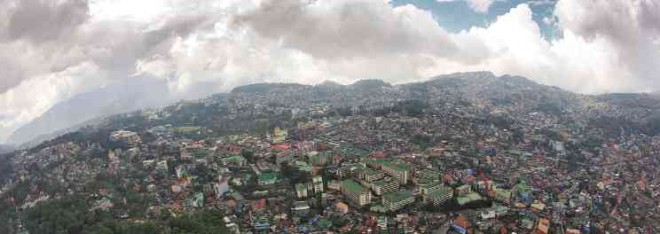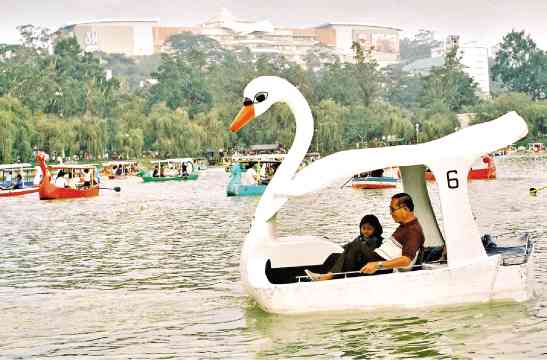More trees, more water, more walking, more heart

BURSTING AT THE SEAMS Baguio City, the country’s summer capital originally built to accommodate only 25,000 people, confronts issues of rapid urbanization, environmental degradation and overpopulation as it celebrates its 106th founding anniversary this year. EV ESPIRITU
DURING Baguio’s centennial in 2009, retired city architect and urban planner Joseph Alabanza asked a group of high school students to sketch on large sheets of manila paper how the summer capital should become when they grow up.
Most of the students drew a city filled with pine trees, surrounding a town center filled with pedestrians.
One of the drawings was intriguing: Students sealed Baguio under a crystalline dome to preserve its remaining forests, its water and its people from uncontrolled urbanization.
It wasn’t the first time that residents—no matter how young—have expressed the kind of Baguio they want.
Shortly after the July 16, 1990, earthquake devastated northern Luzon, the city’s civic leaders and nongovernment organizations gathered to map out a common framework for rebuilding Baguio.
Article continues after this advertisementThe community joined hands with the city government to plan for Baguio’s second reconstruction. The city was rebuilt after World War II ended in 1945, without this kind of community input.
Article continues after this advertisementThis year, a civic movement has been trying to engage people to repeat that process.
“The Baguio We Want” movement, orchestrated and sustained online by social activists, gathered at the University of the Philippines Baguio on Monday, the eve of Baguio’s 106th charter anniversary, to assert the policies and the measure of development they want enforced for the mountain city.
These policies were drawn up in a Feb. 25 People’s Summit which was convened by Baguio Bishop Carlito Cenzon to address seven core issues—the environment to include waste management, trees, water and air pollution; land use and zoning; community participation; governance and legislation; well-being and mobility; local businesses and tourism; and city heritage— which affect the lives of every Baguio citizen, said UP Baguio Chancellor Raymundo Rovillos.
“[The movement’s output] serves as a guide to all the people of Baguio [to] make them aware of the Baguio that we want. It also [encourages people] to be more socially engaged … so that everyone can take part in the revolution—in the change that we want for Baguio,” Rovillos said.

SAVE TREES Baguio students joined a protest rally to preserve trees that were cut or relocated to make way for the expansion of a shopping mall in the city in 2012. RICHARD BALONGLONG
Getting people involved
Getting more Baguio people to be involved in how the city should be governed is outlined in the movement’s policy statement: “We want to be a community where its citizens take part and own the progress made in developing their neighborhoods. We need citizens who know their own leaders. We need a community which takes time to listen to its citizens’ needs and for these needs to be addressed by community leaders, who do not kowtow to political patrons.”
Many of the issues and proposed solutions raised for a modern Baguio were also the elements of the 1991 NGO Congress output that suggested that improving the city was a continuing struggle.
For example, the People’s Summit urged the city government to impose a moratori um on the construction of high-rise buildings until residents study the laws, technologies and policies governing Baguio’s skyline.
In 1991, the NGO Congress urged Baguio to maintain a four-story building limit and proposed a medium-scale buildup for Baguio after most of its structures were toppled by the quake. As of June 30 this year, Baguio hosts 60,340 buildings, according to the city building and architecture office.
Decongestion
The People’s Summit also examined a Baguio urban decongestion proposal called BLIST which requires the city to give up some of its investments, to be farmed out to neighboring Benguet towns. BLIST stands for Baguio and its neighboring towns of La Trinidad, Itogon, Sablan and Tuba.
Conceived by Alabanza when he served as Cordillera director of the National Economic and Development Authority in 1990, BLIST was redeveloped two decades later into an economic sharing arrangement because some of the component towns remained suspicious about being paired with an overpopulated, water-parched upland metropolis.
The arrangement also added Tublay town in the renamed BLISTT.
The People’s Summit said: “We need BLISTT to be an initiative of the people, not just the government’s. We need BLISTT to operate regardless of who is in office. BLISTT needs to have a land use plan.”
Satellite cities
In an Aug. 31 post shared on “The Baguio We Want Forum” Facebook page, architect Rafael Chan carried the BLISTT idea further by proposing the establishment of satellite cities.
“The vision is to codevelop our adjoining localities to have satellite cities … This initiative will make other locations equally attractive as business locations and living environs, and encourage many to consider them as worthy alternatives to Baguio,” he said.
Chan also revived a crusade to pedestrianize downtown Baguio.
“We cannot expect that our roads will ever be able to convey the excessive number of cars that converge upon us … [Limiting or totally removing] private cars from the central business district (CBD), a continually moving flow of public transport [through a proposed CBD] circumferential route will make possible the decongestion and depollution of our city center,” Chan said.
“Constantly repeating the planning mistakes of our historical and recent past is actually the main reason we make very little progress with [developing] sustainable solutions to the problems that continue to plague us,” he said.
The movement continues to draw insights from people. It has yet to address the existence of homeless people in Baguio streets and squatting that is aided and empowered by overlapping national laws.
Unlike the NGO Congress, “The Baguio We Want” movement also appeared to have a strained relationship with the city government.
“Wala tayong kaibigan sa City Hall (We don’t have friends in City Hall). We found this out [the] hard way,” Monin Navarro, one of the movement’s leaders and a member of its heritage cluster, said during Monday’s assembly.
